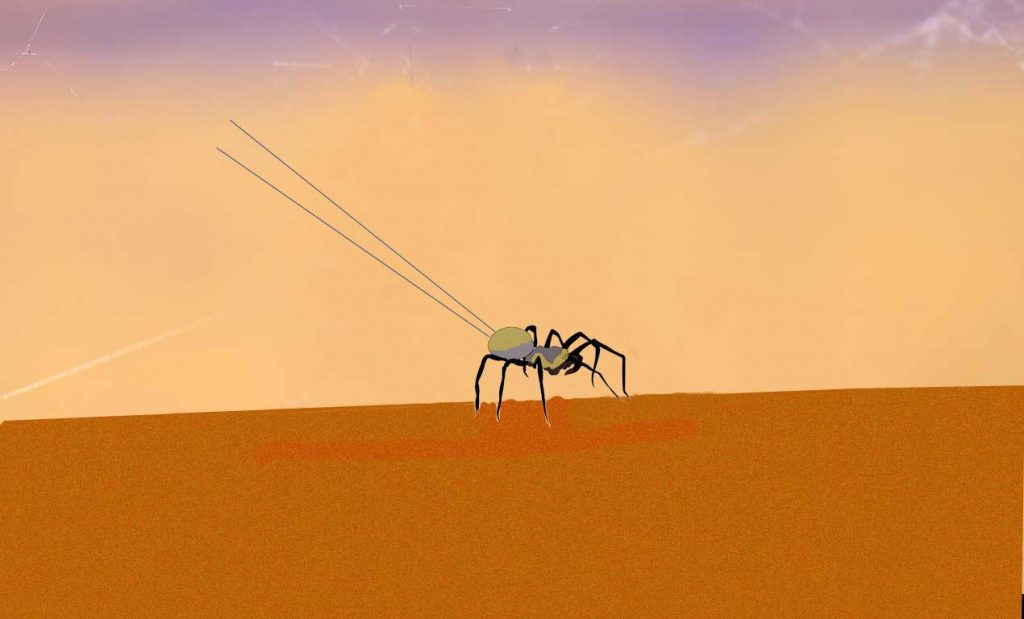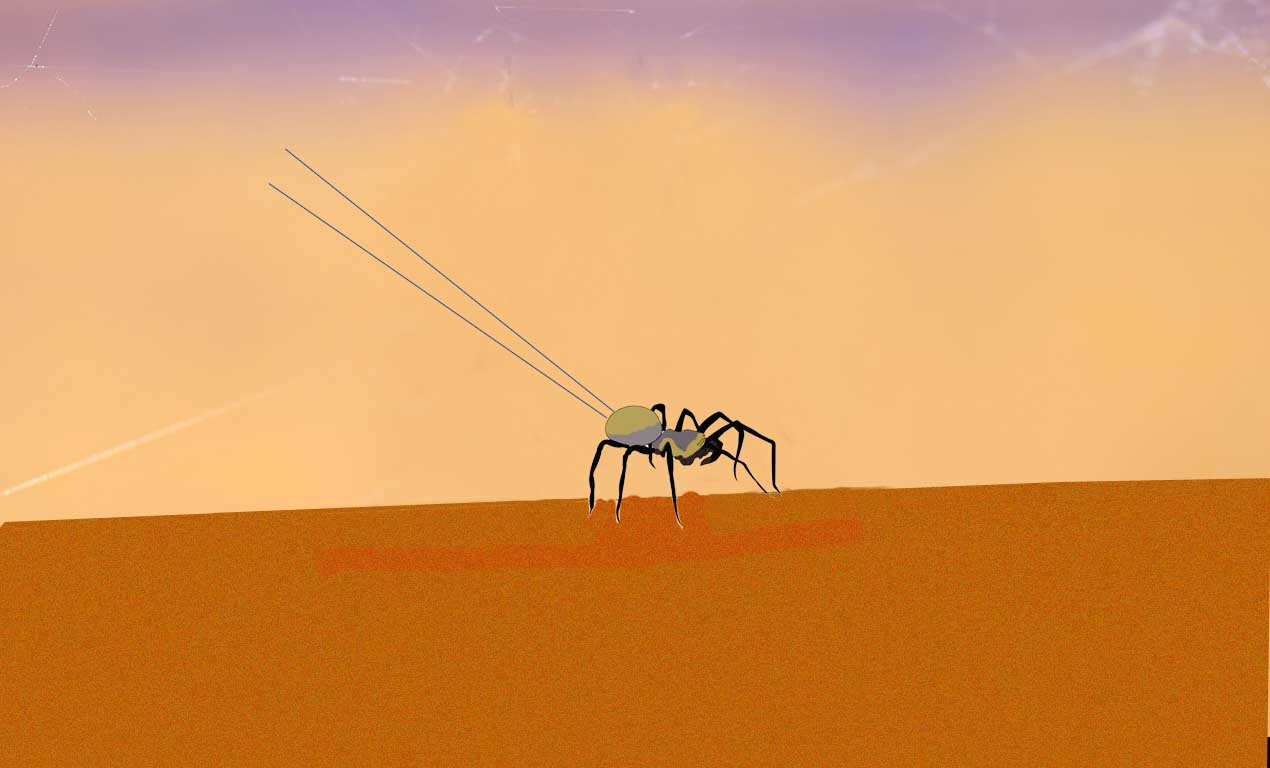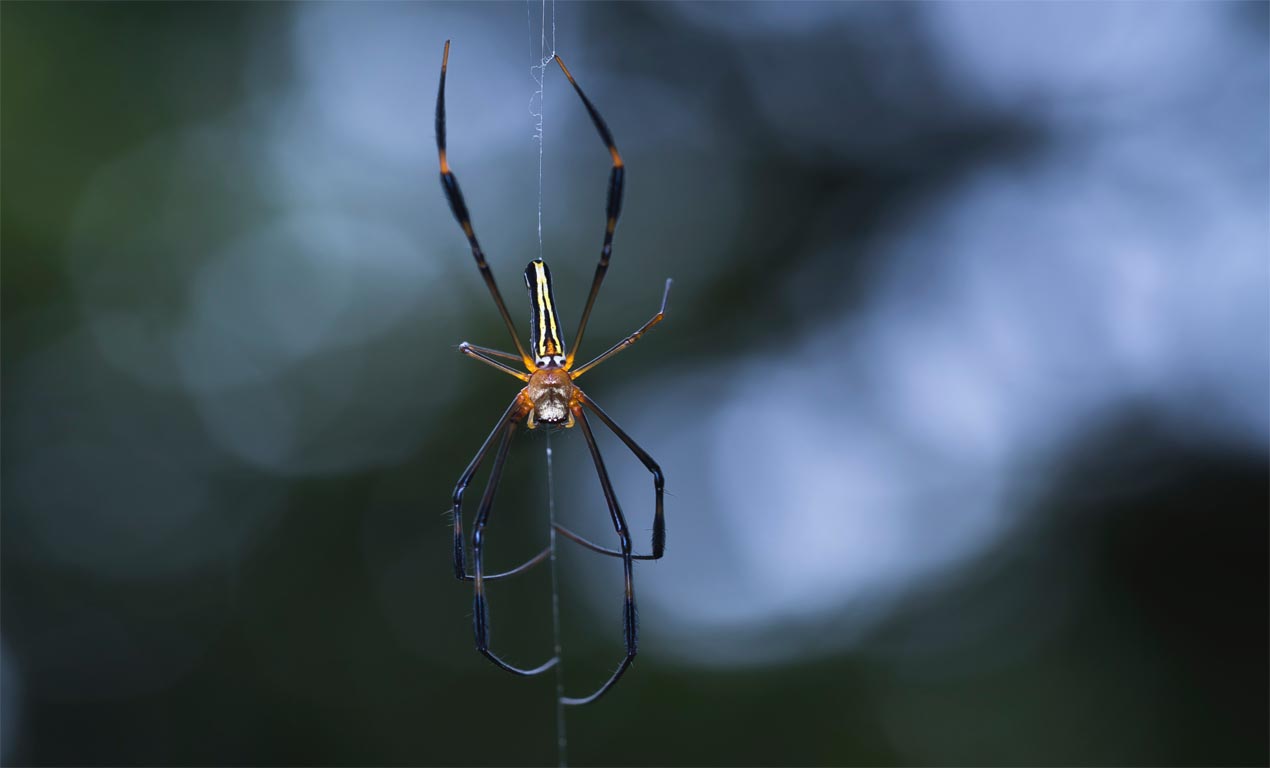
 Spiders are air-breathing arthropods that get found across all continents except Antarctica. They are the most significant order of arachnids, having eight legs and chelicerae with fangs that can inject venom. Scientists have seen them flying, and that’s where it all began, i.e., the concept of flying spider.
Spiders are air-breathing arthropods that get found across all continents except Antarctica. They are the most significant order of arachnids, having eight legs and chelicerae with fangs that can inject venom. Scientists have seen them flying, and that’s where it all began, i.e., the concept of flying spider.
But can spiders fly? The answer is yes spiders can fly, but they can’t fly on their own, so they use a trick to fly. They use the earth’s electric field to fly. They wait for the right condition, and when the wind, the electric field is right, they lift their abdomen and tiptoes, then they release a strand of silk and takes off. This process is known as ballooning.
Continue reading to know about this in details.
Little Bit About Spiders
Spiders usually have two main body parts, the cephalothorax, and the abdomen joined together with small, cylindrical pedicel. They do not have antennas, their central nervous system gets located in cephalothorax, and their eight legs use hydraulic pressure to get extended.
Their abdomen have appendages, which get modified as spinnerets. These produce silk from over six different glands, which get used in building cobwebs and locomotion of spiders. They are mostly predatory, feeding on various types of insects. They use multiple tactics to snare their prey. They use their webs, bolas with their silk threads, and runs after them swiftly.
They mostly detect their prey through vibrations. They cannot eat solid food, and hence secrete digestive enzymes, liquefies and then feeds on it. They grind the food particles with the base of their pedipalps. Female spiders are known to kill and eat the male spider during copulation; hence the males conduct various elaborate courtship rituals to avoid being killed.
Spiders, on average live for around two years. Females weave egg cases made of silk, which contains hundreds of eggs. Most females take care of their young ones and carry them around for food. Some spider venom is dangerous to humans. The silk from spiders is lightweight, durable, and elastic, which is far superior compared to synthetic fibers.
Body Parts
Spiders have segmented body parts, covered by cuticles, made of chitin and protein. Even their head gets formed from several segments, holding the mouthparts. Their chelicerae pair is short and has a fang at its end, which injects the venom. Their top mouth part consists of a brush-like structure to filter out solid food. The appendaged lower section is the pedipalps, required for feeding. The males have a more extensive last section, which gets used for sperm transfer.
Circulation:It has a cavity known as hemocoel, which runs along the entire body length, through which blood flows. They have a tubular heart in the cephalothorax, and arteries carry the blood to various parts of the body through one-way valve. Spiders have an open circulatory system.
Respiration: The respiratory system of spiders is a mix of tracheal and book lung system. In the book lung systems, the respiratory pigment hemocyanin transport oxygen very well. For the tracheal system to operate, the spiders have spiracle through which air enters its body.
Feeding: Some spiders do not have fangs and get to use silk to kill their prey. Those with fangs, hold on to the victim, inject digestive juice inside the prey, and sucks in the digested organic mater directly. Those without the claw, use their pedipalps to break down the food along with the digestive secretion.
Digestion: The stomach in the cephalothorax acts as pumps, which send the food to various digestive chambers in the abdomen. The nitrogenous waste gets converted to uric acid. Malpighian tubules collect all these waste from the blood and deposits in the cloacal chambers, which then passes as feces through the anus.
Central nervous system: This consists of a pair of nervous cord connected to a couple of ganglia, which connects to all parts of the spider. This gets primarily found in the cephalothorax.
Sense organs:Spiders have four pairs of eyes, located near the top, the front end of the cephalothorax. They consist of primary and secondary eyes. In the primary eyes, there is some form of image formation, while in secondary, you can locate the direction of the light source.
Spiders have fine bristles or setae on their body cuticles, which gets connected to their sensory nerves. They can differentiate vibrations, touch, and smell through these sensors. Males get attracted to the pheromones of females through these sensory nerves.
Locomotion
Spider’s legs get made of seven segments. The one close to the body is the coxa. The next joint connecting to the long lemur is the trochanter. This gets joined at the knee known as the patella, which gets connected to the tibia. The metatarsus then connects the tibia to the tarsus, which ends in claws. Different species have different types of claws and tufts of bristles known as scopulae.
They use the hydraulic pressure to extend their limbs, and they use the extensor and flexor muscles to do the running and jumping. The scapulae bristles and claws help spiders to walk up the ceiling or polished surface.
Silk Production
 The abdomen has three appendages, which create silk, known as spinnerets. Each of these spinnerets has many spigots, which get connected to the silk glands. Each of these six silk glands produces different types of silk. These glands secrete a particular kind of liquid, and when they get drawn out thro’ the spinnerets, the fine silk-like thread gets produced.
The abdomen has three appendages, which create silk, known as spinnerets. Each of these spinnerets has many spigots, which get connected to the silk glands. Each of these six silk glands produces different types of silk. These glands secrete a particular kind of liquid, and when they get drawn out thro’ the spinnerets, the fine silk-like thread gets produced.
These silk threat has high tensile strength and is elastic. Other than the web, these silk gets used in snaring their prey, climbing down a safety rope, wrapping the sperm or fertilized egg cases.
Size And Coloration
Spiders come in various sizes – from mere 0.4mm to 9cm in length. They usually get found in three primary pigments – ommochromes, bilins, and guanine. Different shades get found due to the refraction of light and bristles on the surface of their cuticles.
Feeding
Spiders are nocturnal species and are predatory. Some species are known to feed on vegetation and nectars from flowers. The young spiders feed on nectar or other sugary parts of plants and fruits. Some are known to scavenge or feed on their exoskeleton after they molt.
Defense
The earthy color of spiders helps them against predators like birds and wasps. They blend with the background. Some get developed color patches and stripes, which camouflage them with their surroundings. The silk web and threads help them with their escape if their predator gets entangled in them.
Capturing
Spiders get to catch their prey in various unique ways. Let’s look at some of the ways:
Web:Web-building spiders are practically blind, but are very sensitive to vibrations. They build a web to snare their prey. The horizontal web traps insects rising from the vegetation and the ground, while the vertical webs hold on to flying insects.
Water webs:The Argyroneta spiders build their web underwater, where they live, lay their eggs and breed. The same web also traps their prey, which they feed on. The web also gets built on the water surface, and when an insect gets stuck, the tug on the web informs the spider about the catch, which gets then fed on.
Net casting: Here, the spiders use small webs to catch their prey. Hyptiotes spiders stretch their webs and release them when a victim strikes. Deinopidae spiders weave smaller webs and hold them with their outstretched frontal legs, and can trap their prey either forward or backward. These insects could be either crawling or flying.
Bolas: Mestophora female spiders build webs made of only a single strand of silk, like a trapeze, which they patrol. They prepare a silk string with a silk ball at one end, which gets secreted with pheromones of wasp. They swing these balls of silk at the flying wasp, and 50% of the time, they are successful in trapping its prey. If for thirty minutes, they are unable to catch a victim, they eat these bolas and prepare a fresh bolas to attack. Young and male spiders do not make bolas. They secrete moth pheromones, attract them, and then kill them.
Trapdoor and vision:Some species of spiders make a trap of web, for a crawling insect to fall through and get trapped. Others use their vision to run down their prey.
Ant-mimicking: This is another trick that gets deployed by some species of spiders. They raise their first two legs like an antenna. They develop patches around the eyes to give them compound eye shape. The tiny bristles on top of their cuticle get shiny and reflect light. They also walk in a zig-zag fashion, just like the ants. When a curious ants approach them, they get attacked.
Types Of Web

Similar species of spiders weave different types of web. Some of the most common webs are as under:
Orb: These webs did not have concentric forms, but made of silk strands with the epicenter far from where the spider was present. Once a prey gets entangled, they quickly drop down on them. Some add shining silk on these webs to attract other insects.
Cobwebs: Theridiidae spiders get known for making proper cobwebs, which take a long time and a large amount of silk. There is a reduction of such cobwebs getting built these days.
Can Spiders Fly?

In 1832, Charles Darwin observed that there were innumerable spiders aboard his ship, many miles away into the sea. He suggested that this could be due to the electromagnetic forces. His notes and observation have been a source of debate for more than a century.
However, his observations led to various innuendos about the flying spiders. They got known to create silk from their spinnerets, and when caught in the wind, the spider could float quite a distance, attached to his silk.
Whether they could float miles away from the shore into the sea or get drowned after sometime is a conjecture, which is unknown. Is there any particular type of spider which prefers to float on their silk thread, away from their mooring is another area of uncertainty.
Spiders do not have wings but got thought to go up a perch, puff its abdomen and spin out lots of silk yarn, which would catch the breeze and take them with it! Though this does not seem possible, spiders got found at various altitudes, away from their habitat. This gave wings to the theory of ballooning spiders.
Peter Groham: An astrophysicist at the University of Hawai, first came up with the idea of flight using electrostatic. His theory got based on Darwin’s observation and his understanding of electrostatic energy in the atmosphere. His theory of electrostatic repulsion and its probability to help in-flight got published on an open-access platform in 2013.
Morley and Robert: For five years, Morley and the team found this theory of Groham intriguing and started researching on this concept. In 2018, Erica Morley and Daniel Robert from the University of Bristol came up with the idea of spiders using the earth’s electrostatic field to float. Electrostatic field: Morley and Robert’s theory is this – our earth’s surface gets negatively charged, and as we got higher up in the atmosphere, the charge becomes positive.
The concept of thunder and lightning is part of this phenomenon. Every day, thousands of thunderstorms around the world produce a massive amount of electrostatic field, of which some get earthed when the lightning strikes the ground. The rest of the electrostatic energy is present in the atmosphere.
The silk which leaves the spider’s body gets negatively charged, which gets repelled due to the negative charge present of the surface of the earth — this result in lifting the silk along with the spider. Spiders seem to understand this logic. It has got found that they reach up to edges of branches and leaves, where the negative charge is least, and there is the presence of a positive charge in the atmosphere.
Can Spiders Detect Electric Field?
Morley and Robert got conducted a test to check if spiders detected electric field. In an airtight plastic container, they placed a few spiders along a card strip, halfway from the ground. They created a negative and positive charge below and above the box, similar to the atmosphere. It got noticed that the tiny sensory bristles of the spider’s feet, known as trichobothria, seemed to get ruffled.
This made the spiders stand erect and puff their abdomens up. Many of the spiders got found to be airborne! When the charges got switched off, they collapsed to the floor of the container. Thus Erica Morley, a sensory biophysicist, who led this experiment, put an end to this endless debate.
Trichobothria: Morley got conducted many experiments to identify the particular trichobothria sensory bristles to identify electrostatic change among all other sensory bristles of spiders. This got activated their ‘tip-toeing’ on all four legs with their abdomen arched up, got her team very excited. When they were able to regulate the floating spiders with changes in the electrostatic charges, they concluded with their theory.
Ballooning: Spiders got found floating up to three miles above the earth’s surface and around thousand miles into the ocean surface. This got earlier thought to be ballooning using strong winds against their silk yarn. However, there was no reason found when they got seen flying even without any breeze. Now, with the theory of ballooning with the electrostatic field is much more realistic, since this charge is ever-present in the atmosphere.
APG: The atmospheric potential gradient (APG), is the global electromagnetic circuit, forever present between the earth’s surface and the ionosphere. Depending upon the suitability of this condition, mass ballooning of spiders get noticed on a particular day and not on other days. Hence the probability of these tiny creatures understanding nature, much better than us, seems to gain ground.
The Morley team is now looking at other small insects and their behavior concerning electrostatic forces. Spiders have been ballooning to newer pastures for breeding and food, away from competition and predators. Whether all species of spiders can achieve this technique is still not clear. The experiment got carried out with Linyphiid spiders.
Can Spiders Fly Across Oceans?
They can travel miles after miles just by releasing a long silk thread and using Earth’s electric field. With this technique, they can cross oceans and go to other countries; in fact, this is how spiders travel and spread across the globe. Because of their physiology, they can achieve this feat. Imagine if we could do that.
Even bigger spiders do that. Spiders can sense the electric field, so when they sense the right amount of electric field, the small hair on their legs stands up. When we get exposed to static electricity, our hair also stands up. Unfortunately, we can’t use that for flying across the ocean.
This thing has baffled scientists for many years because it is something that is almost impossible to believe, but they do it very often. It’s proven now.
They can go up to 2 miles above the surface while ballooning. They can land in the middle of the ocean on any ships or stranded island. The spiders land when there is not enough electric field, and they fly again when there is an electric field. The Earth’s electric field is more than enough to give them lift, but they use both the electric field and wind to do ballooning.
Conclusions
‘Ballooning’ of spiders has been noticed for many years now. Spiders have been found high up in the atmosphere and far away into the seas. The general understanding was that the strong wind blew the silk thread with which the spiders were clinging on to. However, recently concluded and published report suggests that the actual reason for ballooning is the electrostatic field present between the earth’s surface and the atmosphere. Hence, spiders don’t fly but can take up aerial travel through the concept of ballooning.
Welcome to my blog. I have been doing pest control for years since my house, garden and pets were always attacked by various kinds of pests and as a result I had to know proper pest control techniques that works. In this blog I share all the tips and tricks that I know and I hope you’ll find it helpful.
